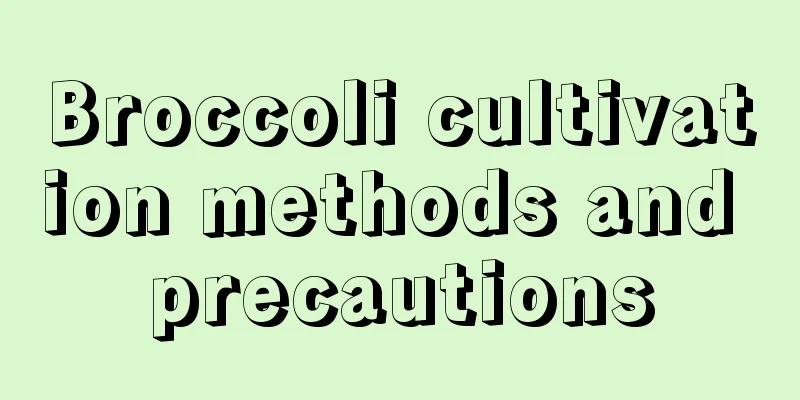Broccoli cultivation methods and precautions

1. Maintenance methods1. Substrate selection: Broccoli grows well in loose, breathable, well-drained acidic soil. You can mix bean dregs, animal manure or leaf mold with the soil and then plant it. You can also add nitrogen fertilizer to increase soil fertility. 2. Water management: When growing broccoli, the soil needs to be kept moist but without water accumulation. It is recommended to water it every 5 to 6 days. When it is dry and there is no rain, increase the frequency of watering depending on the situation to keep the soil moist. When it rains heavily, drain the water frequently to prevent the broccoli from getting sick. 3. Nutrient management: Apply a mixture of nitrogen fertilizer and potassium chloride two to three times during the rosette stage. Phosphorus fertilizer and nitrogen fertilizer need to be applied during the flower head expansion period. Foliar fertilizer can be sprayed with trace elements such as boron, molybdenum, and magnesium. 4. Light management: Broccoli likes to grow in places with plenty of sunlight. Adequate light can promote photosynthesis of broccoli, which not only produces sufficient nutrients for the plant, but also makes the surface of the broccoli greener and the appearance more beautiful. The sunlight is strong in summer, so take sunshade measures. 2. Breeding techniques1. Sowing: When sowing broccoli outdoors, dig a 1.3 cm hole every 8 to 14 cm, then sprinkle a small amount of seeds in the hole, cover with a thin layer of soil, and water in time after sowing. 2. Summer: The best growing temperature for broccoli is 14℃ to 24℃. Too high temperature is not conducive to its growth. The light is strong in summer and needs shading. After heavy rainfall, drain the water in time to prevent it from rotting. 3. Problem diagnosis and treatment1. Soft rot: It is easy to occur when there is rain or a lot of water. Bacteria will enter through the wounds on the roots, leaves, etc., causing the plant to gradually rot. Drain the water frequently in summer, and spray the soil with sulfate chain toxin diluted with water after the disease appears. 2. Cabbage worm: Cabbage worm mainly feeds on leaves. In serious cases, it will eat the entire leaf. Its feces will also affect the sales of broccoli. After discovery, it is recommended to dilute Greenworm Fungus No. 6 with water and spray it evenly on the plants. IV. Other issues1. Is it toxic: non-toxic. The broccoli you buy should be eaten as soon as possible. If you cannot finish it, it is recommended to blanch it or seal it with plastic wrap. 2. Can it be hydroponically grown: It cannot be hydroponically grown. Broccoli is prone to soft rot when there is too much water, so it cannot be grown hydroponically. |
<<: Cultivation methods and precautions of evening primrose
>>: How to grow shallots and what to pay attention to
Recommend
Brother Wang has a trick for growing flowers. Feed the flowers with some "thin oil and water", and the Christmas cactus will bloom vigorously in every pot!
For example, Brother Wang, Huahua’s next-door nei...
How to care for newly bought white crystal chrysanthemum
1. Soil White crystal chrysanthemum has relativel...
Introduction to the types of creepers
Introduction Ivy: Parthenocissus genus, Vitaceae,...
Want to fatten up your succulents? I starved it for a few meals and it actually grew fat!
Why can Rourou grow into a fat boy by skipping a ...
What to do if climbing roses don’t bloom
1. Lack of light It prefers warm and sunny places...
What to do if the leaves of the potted rainbow arrowroot turn yellow
1. Water appropriately If you water too much duri...
How to grow daffodils
1. Breeding points 1. Choose soil: Daffodils can ...
How to prune a dragon blood tree (pruning time and method)
When to prune the dragon blood tree The best time...
The role of taking root
Ornamental value There are many varieties of brom...
When is the best time to repot Tigerthorn plum? In which month is it suitable to repot?
Time to repot tiger thorn plum Euphorbia milii ne...
How to grow Dendrobium
1. Temperature The temperature suitable for the g...
Throw fruit seeds into a pot, green sprouts will appear, and 100 fruits will be produced in one year!
litchi Eat the remaining lychee cores, remove the...
How to prune crape myrtle
Pruning methods Crape myrtle is generally pruned ...
What is Gesang flower and when does it bloom?
1. What kind of flower is it? There is no exact d...
How to fertilize the money tree in spring
1. Relatively abundant fertilizer can make its le...









